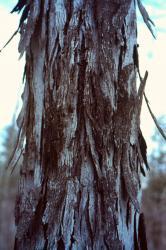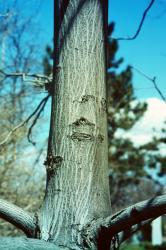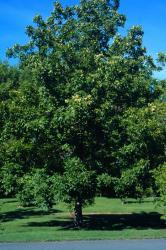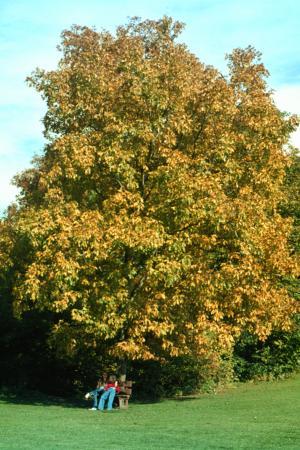| Carya ovata Shagbark hickory
|
| Description | Like a shaggy dog, the more you get to know the Shagbark Hickory, the more you will like it. Though dropping plant parts may face some opposition, this attractive, urban tolerant tree has an important role in the healthy diversity of tree species in the urban forest. |
| Usage | Shade tree, specimen, highway |
| Origin | Southern Ontario into Quebec, much of eastern USA |
| Hardiness zone | 4,5 |
| Size | 18-22m |
| Form/texture | Narrowly oblong-cylindrical, open branching habit. Medium texture |
| Growth rate | Slow; long lived |
| Leaf | Alternate, pinnately compound, five leaflets, striking yellow and golden brown fall colour |
| Flower | Showy catkins in May Monoecious |
| Fruit | Most tasty of hickories, ovata refers to the shape of the husk. Choice food for squirrels, larger birds, humans. One large tree can produce up to 630 litres of nuts (Harlow). |
| Exposure/culture | Some shade tolerance. Found on a wide range of soils from sand and gravel to clay and from dry to wet. Large taproots make for transplanting challenges. Few pests and diseases, though habitat to many species (Waldron). Sensitive to deicing salt (Beckerman et al) |
| Comments | Perhaps one of Ontario's toughest native trees, this species can often be found growing in dry, rocky conditions in the wild. It is an important component of the oak-hickory forest, and food for wildlife. "A shagbark can usually be distinguished as far as it can be seen by the smoke-grey bark which is forever warping away from the stem in great plates a foot long or more, and 6 or 8 inches wide. Frequently the strip is loose and curling at both ends, and is only more or less loosely attached by the middle while its edges usually touch those of another strip of bark, so that if one tries to pull it free from the trunk, it is so engaged on both sides that one soon gives up the task. True there are other trees with exfoliating bark, but none in our sylva with such great segments, so long or so thick" (Peattie). The shedding bark, dropping petioles and fruit may be too messy for the fastidious gardener or maintained turf areas. With this coarse appearance the shagbark hickory may not be a landscape favourite; it should be grown to become the stately shade tree that it is. As with all hickories, this species is very rarely cultivated due to the challenges with transplanting. Modern production systems utilizing "air-pruning" technology may provide some solutions to this challenge. |



Reference:
Beckerman, J. and B.R. Lerner. 2009. Salt Damage in Landscape Plants. Purdue Extension Publication ID-412-W. Purdue University. West LaFayette, IN.
Harlow, W.M. & E.S. Harrar. 1958. Textbook of Dendrology. McGraw-Hill Co., N.Y.
Peattie, D.C. 1964. A Natural History of Trees of Eastern and Central North America. 2nd ed. Bonanza Books. New York, NY. 606pp.
Waldron, G. 2003. Trees of the Carolinian Forest. The Boston Mills Press. Erin, Ontario.
